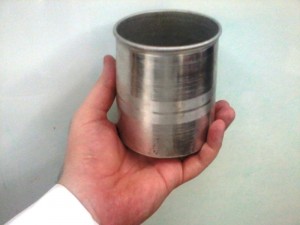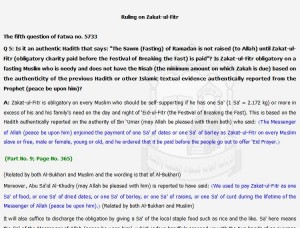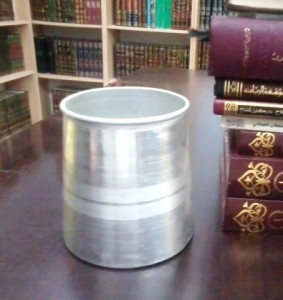Zakaat al-Fitr Measurements: One Saa’ = Three Litres, One Mudd = .75L
In the Name of Allaah, the Most Merciful, the Ever-Merciful…
The Prophet (may Allaah raise his rank and grant him peace) ordered that a fasting person give out Zakaat al-Fitr at the end of Ramadhan – one saa’ of staple food on behalf of yourself and each person you are responsible for. [1]
What is a Saa’?
A Prophetic saa’ ( صاع ) is not a weight measurement. It was and still is a measurement of volume, similar to the size of a large salad bowl. It is made up of four mudds, and amudd ( مد ) is a smaller container, close to the size of a small salad bowl.
To be precise, a Prophetic mudd in modern volume measurements is .75L (or 750mL), which means that a saa’ is three litres.
The Chain of Transmission for this Prophetic Measurement
This mudd was measured up to Sh. Yahyaa ibn ‘Uthmaan al-Mudarris’ mudd (may Allaah preserve him), which was measured up to the mudd of his shaykh al-’Allaamah Aboo Sa’eed Muhammad ‘Abdullaah al-Laknawee (d.1400), which was measured up to his shaykh’smudd… and so on, all the way back to the mudd of Zayd ibn Thaabit (may Allaah be pleased with him) that was in use in al-Andalus and elsewhere, all the way back to (at least) the fourth century.
Al-’Allaamah al-Laknawee (may Allaah have Mercy on him) – a former teacher at the Haram in Makkah and at Daar al-Hadeeth, an Indian scholar grounded in Towheed and firm against the people of desires – said about this mudd:
This is the mudd that the Prophet (may Allaah raise his rank and grant him peace) was speaking about when he prayed, “O Allaah! Put blessings in our saa’ and our mudd!” This was collected by the two shaykhs (al-Bukhaaree and Muslim). Further, he (may Allaah raise his rank and grant him peace) used to make wudhoo’ using this mudd, and he used to take a bath using a saa’. [2]
In one narration of the hadeeth in Saheeh Muslim, the Prophet (may Allaah raise his rank and grant him peace) said when praying for Allaah to bless the mudd and the saa’:(what means), “blessings upon blessings.”
So whoever wants to give their zakat al-fitr using this measurement – as it was prescribed – is free to do so. May Allaah bless the Muslims and accept their fasting and their zakaat.
How to Calculate Your Zakat Al-Fitr
A way of keeping it simple, using the modern equivalent of a saa’ (3L), is to measure out .75L (750ml) of the food you intend to use in a large measuring cup, then use that same amount (whether you convert it to weight or not) a total of four times for each person’szakaat.
This works for any food type, and it eliminates the need for lengthy calculations and conversions that differ from one food type or another, especially since some kinds of rice -for example- are heavier than others. Its true! Even within one food type there are different kinds that have different densities and weights.
So if you want to give out rice, for example, measure 750ml of the kind you have in a measuring cup. If you want to give the zakaat in a sealed unopened container, then weigh the 750ml you measured, and then multiply by four. That’s the weight of one person’szakaat al-fitr using that exact kind of food. Then multiply that by the number of people you are giving zakaat on behalf of.
Step-by-Step Walkthrough
Step 1: Determine the number of people you are giving zakaat al-fitr on behalf of.
A man has a wife and four children, and his parents have asked him to give out zakaat al-fitr for them too. So he needs to give out 8 units, or saa’s, of food.
Step 2: Determine how much one saa’ (3 litres) of the selected food item is.
The man in our example decides to use barley. He can either:
(a) Measure out three litres of barley in a large measuring pitcher, if he doesn’t mind opening the container, and it will not be seen as unacceptable to the poor person.
(b) Measure out 750 ml of barley in a measuring cup. Weigh this amount. Multiply its weight by 4. This is one saa’ of that barley. Let’s say in this example 750ml of the selected barley weighed 400 grams. So 400g x 4 = 1.6kg. The weight of one saa’ of that specific kind of barley would be 1.6 kilograms.
Step 3: Multiply the measurement from step 2 by the number of people you are giving on behalf of (from step 1).
This is done one of two ways:
(a) 3 litres x 8 = 24 litres of barley as in this example (based on the original volume)
(b) 1.6kg x 8 = 12.8 kilograms in this example (converted to weight)
I hope this walkthrough is helpful.
IMPORTANT: Is a Mudd Simply a “Double-Handful”?
The mudd is not simply a double-handful. A mudd is an actual physical container (like a small bowl or pot, or a large cup), a standardized unit of measurement, one that was widely in use in the time of the Prophet (may Allaah raise his rank and grant him peace) in the marketplaces and in their houses.
 It is based on a double-handful –don’t get confused – but the Companions used to buy and sell using the containers (the mudd and the saa’), not their own individual double-handfuls, and they used to give their zakaat al-fitr with these containers (the saa’ and the mudd). The Prophet (may Allaah raise his rank and grant him peace) used to have Zayd ibn Thaabit measure outmudds and saa’s of food using the standardized mudd and saa’ of al-Madeenah.
It is based on a double-handful –don’t get confused – but the Companions used to buy and sell using the containers (the mudd and the saa’), not their own individual double-handfuls, and they used to give their zakaat al-fitr with these containers (the saa’ and the mudd). The Prophet (may Allaah raise his rank and grant him peace) used to have Zayd ibn Thaabit measure outmudds and saa’s of food using the standardized mudd and saa’ of al-Madeenah.
So Allaah did not legislate that big-handed people have to give more zakat al-fitr, and people with small hands give less. Rather there is a standardized measurement to be used, according to how it has been legislated.
Thus, it is known that it is inaccurate to define the mudd referred to in the texts as simply anyone’s “double-handful”, rather the mudd referred to was an actual container, which our scholars throughout history have busied themselves recording its size, shape, volume, and description.
CLARIFICATION: “The Scholars have Specified the Saa’ as 2.172 Kilograms” [?]
In a translation of a fatwaa from the Permanent Committee of Scholars in Saudi Arabia, headed by Shaykh Ibn Baaz (may Allaah have Mercy on him), there seems to be a specification of 2.172 kilograms as one saa’.
 Actually, this is something that has been added to the text of their fatwaa by the translator(s) (between parenthesis). The Arabic original hasNO MENTION of this specification, not in the text of the fatwaa, nor in a footnote. [3] It was simply added by the translator(s).
Actually, this is something that has been added to the text of their fatwaa by the translator(s) (between parenthesis). The Arabic original hasNO MENTION of this specification, not in the text of the fatwaa, nor in a footnote. [3] It was simply added by the translator(s).
This does not mean that such a measurement must be inaccurate, as a saa’ (3L) of some kinds of food might actually weigh precisely 2.172 kg. However, it should be known that this specification did not occur from the scholars in the fatwaa translated and referenced.
And Allaah knows best.
ANOTHER CLARIFICATION: “The Mudd is NOT a cup, bowl, or utensil” [?]
In an informative and generally accurate article, our brother, Aboo Sufyaan Beecher in Kuwait (may Allaah give him success), posted the following words just recently:
I asked our Shaykh, Dr. Aboo Muhammad Fawaaz al-’Awadhee, this evening about the miqdaar [size] of a mudd & saa’ due to the confusion (mine & some others) in regards to different sayings of Ahlul-’Ilm and things posted on the internet. He mentioned the mudd an-Nabawee (Prophetic mudd) is a measurement based on volume that fits in the two cupped-together hands of an average sized man. This was the saa’ of the people of al-Madeenah. He said a mudd is a measurement, not a cup, bowl or utensil.
Source: The Salafiyyah Kuwait Blog
We can address this common misunderstanding with the following textual and rational proofs:
Firstly, Imaam al-Bukhaaree gathered hadeeths about the size of the mudd container in the chapter of his Saheeh called “Chapter: the Saa’ of al-Madeenah and the Prophet’sMudd (may Allaah raise his rank and grant him peace), and How They Were Passed on by the People of Madeenah, Generation After Generation.” (Fat-hul-Baaree: 11/598)
His first hadeeth (#6712) in that chapter mentions that the government-endorsed Saa’container had become noticeably smaller than the standard Saa’ in the time of the Prophet (may Allaah raise his rank and grant him peace), so this was corrected during the Caliphate of ‘Umar ibn ‘Abdil-’Azeez.
The second hadeeth of the chapter (#6713) describes how Ibn ‘Umar used to use the original Saa’ measurement of the Prophet (may Allaah raise his rank and grant him peace) before it had been changed.
Quite simply, how could you have a standardized government-endorsed measurement without a physical container to represent it?!
Moreover, Asmaa’ bint Abee Bakr (may Allaah be pleased with her) said: They used to give their zakaat al-Fitr in the time of the Messenger of Allaah (may Allaah raise his rank and grant him peace) using the mudd container that the people used in their houses to measure their foods with, or the Saa’ container that the people used in their houses to measure their food with. She said: All of the people of Madeenah did likewise, without exception!
This hadeeth was collected by al-Haakim in his al-Mustadrak (#1499, 1/570 of the Daar al-Haramayn printing). Al-Haakim called the hadeeth saheeh (authentic) according to the conditions of al-Bukhaaree and Muslim. Neither ath-Thahabee nor al-Waadi’ee objected to this authentication.
Ibn Khuzaymah also collected the hadeeth in his Saheeh (#2401), and said in his chaper title quite profoundly: “The Chapter Mentioning the Evidence Used to Prove that the Zakat of Ramadhaan was Only Prescribed Using the Saa’ of the Prophet (may Allaah Raise his Rank and Grant him Peace), Not the Saa’ that was Later Invented, Since the Saa’ in the Time of the Prophet (may Allaah raise his rank and grant him peace) in al-Madeenah was his Saa’.”
This shows quite clearly that a mudd is not simply anyone’s double-handful, or the average double-handful, rather it is a standardized measurement, which was obviously a known and widely used container, since the Companions of al-Madeenah all had such Mudd and Saa’ containers in their houses for daily use!
If that is not clear enough as proof to dispel the error that a “mudd is not a cup, bowl, or utensil,” review the famous event that took place between the two scholars – Aboo Yoosuf and Maalik ibn Anas. They differed over the size of the Saa’, so Imaam Maalik requested all the people of Madeenah to bring out their Saa’ containers so they could be measured. As a result, Aboo Yoosuf realized that the Saa’ of al-Madeenah was the correct PropheticSaa’ and abandoned his previous estimation of it.
To dispel any remaining doubts, let us look at the chain for the Mudd container shown in the pictures above:
- This mudd container of 750 ml was considered equal in measurement to the muddof my shaykh, al-’Allaamah Yahyaa ibn ‘Uthmaan al-Mudarris.
- His mudd was measured as equal to the mudd of his shaykh, al-’Allaamah Aboo Sa’eed Muhammad ‘Abdullaah al-Laknawee.
- His mudd was measured as equal to the mudd of his shaykh, Al-Haafith Mahmood al-Baharfaalee.
- His mudd was measured as equal to the mudd of his shaykh, al-Qaadhee Muhammad Ayyoob.
- His mudd was measured as equal to the mudd of his shaykh’s shaykh, Muhammad Is-haaq Aboo Sulaymaan.
- His mudd was measured as equal to the mudd of his shaykh, Muhammad Rafee’ud-Deen.
- His mudd was measured as equal to the mudd of his shaykh, Muhammad Hyaat al-Hanbalee.
- His mudd was measured as equal to the mudd of his shaykh, Abul-Hasan ibn Muhammad Saadiq.
- His mudd was measured as equal to the mudd of Abul-Hasan ibn Abee Sa’eed ibn Abee Yoosuf ibn ‘Abdil-Haqq.
- His mudd was measured as equal to the mudd endorsed officially by Aboo Ya’qoob.
- His mudd was measured as equal to the mudd of al-Husayn ibn Yahyaa al-Yashkuree.
- His mudd was measured as equal to the mudd of Ibraaheem ibn ‘Abdir-Rahmaan an-Najaashee.
- His mudd was measured as equal to the mudd of Aboo ‘Alee Mansoor ibn Yoosuf al-Qawwaas.
- His mudd was measured as equal to the mudd of his shaykh, Aboo Ja’far Ahmad ibn ‘Alee ibn ‘Arboon.
- His mudd was measured as equal to the mudd of his shaykh, Aboo Ja’far Ahmad ibn Akhtal.
- His mudd was measured as equal to the mudd of his shaykh, Khaalid ibn Ismaa’eel.
- His mudd was measured as equal to the mudd of his shaykh, Aboo Bakr Ahmad ibn Hanbal (not the famous imaam).
- His mudd was measured as equal to the mudd of his shaykhs, Aboo Is-haaq Ibraaheem ibn ash-Shintheer and Aboo Ja’far ibn Maymoon.
- Their mudds were measured as equal to the mudd of the noble Companion, Zayd ibn Thaabit (may Allaah be pleased with him).
And this chain of narration (ijaazah) for the Prophetic mudd was only mentioned to clear up the confusion that some people may have regarding the mudd not being an actual container. With this, I hope there is no place remaining for further confusion about what a mudd and saa’ actually are!
And Allaah knows best.
Written by: Moosaa Richardson
ST Archives - Originally published September 2009, since updated and edited.
FOOTNOTES:
[1] Collected by Al-Bukhaaree & Muslim.
[2] An-Najm al-Baadee, Shaykh Yahyaa al-Mudarris’ biography (p.63)
[3] Fataawaa al-Lajnat ad-Daa’imah (9/364)

No comments:
Post a Comment